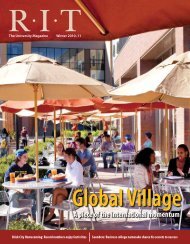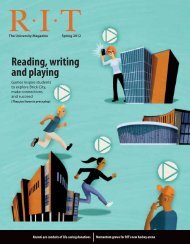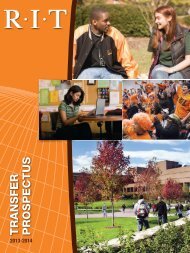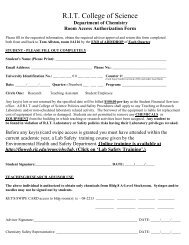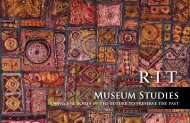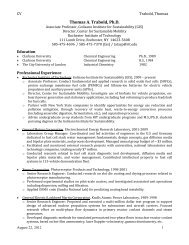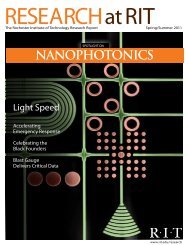Fall / Winter 2012 - Rochester Institute of Technology
Fall / Winter 2012 - Rochester Institute of Technology
Fall / Winter 2012 - Rochester Institute of Technology
Create successful ePaper yourself
Turn your PDF publications into a flip-book with our unique Google optimized e-Paper software.
w<br />
Related Focus Area | Public Research Safety<br />
RFID applied to hygiene<br />
Frequent washing <strong>of</strong> the hands<br />
is one <strong>of</strong> the best ways to stop<br />
the spread <strong>of</strong> germs and prevent<br />
infection. In the sterile realm <strong>of</strong><br />
a hospital, hand washing is an<br />
especially crucial routine for<br />
Edward Walsh<br />
personnel in order to prevent the<br />
spread <strong>of</strong> diseases to patients<br />
who may have an increased<br />
susceptibility to germs.<br />
An RIT-<strong>Rochester</strong> General<br />
Health System (RGHS) Alliance<br />
Gill Tsouri research team has been working<br />
on a project to monitor compliance<br />
with hand hygiene procedures. The project<br />
utilizes Radio-Frequency Identification (RFID)<br />
technology in order to create a database to<br />
be used for evaluating the rates <strong>of</strong> compliance<br />
with hand hygiene procedures. These rates will<br />
then be correlated with the spread <strong>of</strong> diseases<br />
in the hospital. RFID is an electronic tag that<br />
is incorporated into an ID badge that can be<br />
sensed using radio waves for the purpose<br />
<strong>of</strong> identification and tracking.<br />
Gill Tsouri, assistant pr<strong>of</strong>essor <strong>of</strong> electrical<br />
engineering and director <strong>of</strong> the Communication<br />
Research Laboratory at RIT, and Dr. Ed Walsh,<br />
head <strong>of</strong> infectious diseases at <strong>Rochester</strong><br />
General Hospital, have developed and tested<br />
a prototype system for use at RGH. They<br />
hope ultimately to use the technology to<br />
create a hospital-wide database <strong>of</strong> hand<br />
hygiene compliance as well as investigate<br />
additional applications for RFID systems in<br />
the health care industry.<br />
“RFID systems are currently being deployed<br />
in health care facilities primarily for the purpose<br />
<strong>of</strong> equipment tracking,” says Tsouri. “However,<br />
by modifying the algorithms and statistical tools<br />
used in the technology, we were able to track<br />
human behavior, in this case hand washing<br />
compliance, and collect data that could be<br />
used to improve hygiene procedures.”<br />
The project was a finalist for the 2011<br />
RFID Journal Awards, which recognize<br />
Patient area<br />
Hospital room<br />
RFID technology, applied to a hospital environment,<br />
allows medical personnel to be tracked<br />
when they come in close proximity to the tag<br />
reader. This creates a record <strong>of</strong> hand washing<br />
and contact with the patient for future analysis.<br />
projects that illustrate successful use <strong>of</strong> RFID<br />
tech nology or the introduction <strong>of</strong> a valuable new<br />
RFID product or service.<br />
Improving Global Vaccine Affordability<br />
Combination vaccines for young<br />
children are commonly used in<br />
industrialized nations because<br />
they provide protection for<br />
multiple diseases in one single<br />
injection. However, combination<br />
Ruben Proano<br />
vaccines are prohibitively<br />
expensive for developing countries and may<br />
not be available until several years after they<br />
are commercialized in industrialized countries,<br />
when market prices become more affordable.<br />
As a result, the choice <strong>of</strong> vaccines used by<br />
the developing and industrialized world to<br />
immunize children against similar pediatric<br />
diseases is rapidly diverging.<br />
Ruben Proano, assistant pr<strong>of</strong>essor <strong>of</strong><br />
industrial and systems engineering at RIT,<br />
together with Sheldon Jacobson, pr<strong>of</strong>essor <strong>of</strong><br />
computer science at the University <strong>of</strong> Illinois,<br />
and Wenbo Zhang, a graduate engineering<br />
student at RIT, are working to reduce the cost<br />
<strong>of</strong> combination vaccines and increase their use<br />
in the developing world. Through the utilization<br />
<strong>of</strong> optimization models, Proano is seeking to<br />
determine conditions that would make the<br />
vaccine market financially more attractive.<br />
Optimization models are used to assess<br />
the best possible choice from a set <strong>of</strong><br />
alternatives. Proano’s team used the technique<br />
to determine the most affordable and pr<strong>of</strong>itable<br />
price for combination vaccines that can be<br />
<strong>of</strong>fered to different market segments.<br />
“We can recommend how many vaccine<br />
doses each market segment should buy, the<br />
Ruben Proano is utilizing optimization models to help make combination vaccines affordable to developing<br />
nations through the better management <strong>of</strong> supply. The graph above measures the change in total<br />
social surplus (or total well being), total pr<strong>of</strong>it for vaccine manufacturers, and total savings for vaccine<br />
buyers as the supply <strong>of</strong> the most expensive and complex vaccine (bundle 15) becomes more available.<br />
vaccine producers that best meet particular<br />
demand, and the range <strong>of</strong> prices available per<br />
dose,” he adds. “Using optimization modeling<br />
and considering the vaccine market as a whole<br />
can allow for a more efficient negotiation<br />
between buyers and sellers in which both<br />
can come out ahead.”<br />
The research was funded in part by the<br />
National Science Foundation and results<br />
were published in Omega, an international<br />
journal <strong>of</strong> operations management.<br />
Proano has also sought to enhance global<br />
understanding <strong>of</strong> vaccine supply problems<br />
and promote the use <strong>of</strong> optimization models<br />
as a potential solution. This includes presenting<br />
his research at the United Nations in New York<br />
City and serving as a member <strong>of</strong> an <strong>Institute</strong> <strong>of</strong><br />
Medicine expert panel on how to model vaccine<br />
prioritization.<br />
“It is my hope this work will lead to the<br />
implementation <strong>of</strong> optimization modeling in<br />
vaccine supply, demand, and pricing both by<br />
individual producers and by international<br />
bodies such as the World Health Organization,<br />
ultimately increasing combination vaccine use<br />
and lowering its cost,” he adds.<br />
Research at RIT<br />
7



